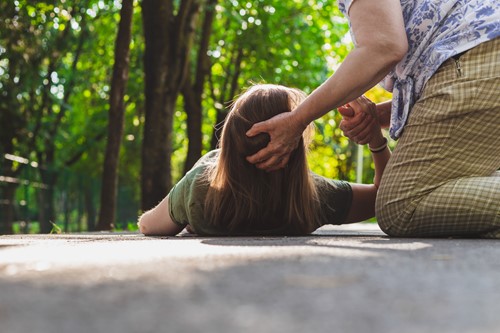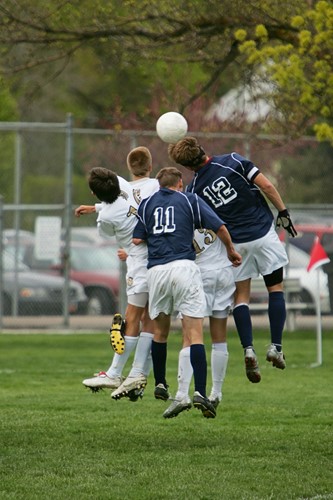
Head Injuries and Concussions
8/15/2022
We previously learned about basic first aid, how to provide care and when to seek emergency care. Now we will delve into head injuries. Head injuries are damage to the scalp, skull, and brain. Head injuries are common pediatric injuries with over 500,000 children being evaluated in the ER every year due injuries. Head injuries can result from falls, car accidents, sports-related trauma, and child abuse. Teens are at highest risk for head injuries with boys having twice as many head injuries as girls. We also see more head injuries in summer and spring when children are more active.
TYPES OF HEAD INJURIES
Head injuries can be classified as a concussion, contusion, or skull fracture.
A concussion results in the brain not working normally for a period of time. This period may be brief or may be longer lasting. We will learn more about concussions below
A contusion is a bruise on the brain that may cause swelling in the inside of the brain where the brain was struck OR on the opposite side where the brain hit the skull. It can also result in tearing of the lining of the brain and blood vessels in the brain.
A skull fracture is a break in the skull bone. Fractures can be linear, depressed, or basilar. Linear skull fractures are a break in the bone but the bone does not move. Monitoring is required but no treatment is usually necessary.
A depressed fracture results in part of the skull sinking into the brain and pressing against the brain. A person with a depressed fracture may or may note have a visible cut. This type of fracture requires emergency evaluations and possible surgery to correct it.
A basilar fracture is a break at the base of the skull and is very serious. You may see bruising around the eyes or ears and clear fluid draining from noses or ears due to a tear in the covering of the brain that is common with this type of fracture. This type of fracture always requires evaluation and treatment.

RISK OF HEAD INJURIES
Head injuries can range from a mild bump to severe brain injury. The brain only has a small amount of room in the skull. Therefore, any swelling can cause a decrease of blood flow to certain areas of the brain. This can lead to brain damage. The damage from head injuries can cause physical impairments, cognitive impairments, and emotional impairments.
Physical impairments include the following symptoms or impairments of
- Speech
- Vision
- Hearing
- Headaches
- Motor Coordination
- Tight muscles or Spasticity of muscles
- Paralysis or inability to use muscles
- Seizures
- Balance
- Fatigue
Cognitive Impairments can include impairments of
- Short term memory
- Concentration
- Thinking speed
- Attention Span
- Ability to plan
- Writing
- Reading
- Judgment
Emotional impairments can include
- Anxiety
- Depression
- Mood Swings
- Self-centeredness
- Low self-esteem
- Sexual dysfunction
- Restlessness
- Lack of motivation
- Difficulty Controlling emotions
WHAT IF YOUR CHILD HAS A HEAD INJURY
If your child suffers a head injury, treatment will depend on the severity of the injury and your child’s symptoms.
The following advices DOES NOT APPLY if
- Your child is under age 2
- Has a neck injury
- Suffered a laceration
- Has other injuries/possible broken bones
- Has a bleeding disorder
- Has a seizure or movement disorder
- Was injured due to child abuse
If your child falls into any of these categories, you should call your provider or seek medical care.
Loss of Consciousness
If your child suffers a loss of consciousness during a head injury, please call 911 right away. They will need to be evaluated immediately and may require testing and imaging to determine the extent of injury and any treatments required.
No Loss of Consciousness
If your child has a mild bump or head injury, check them over them immediately. They should be alert and responsive. They may cry but most will usually stop within 10-15 minutes of the injury. Apply a cool compress to the area of injury. You will want to monitor them for any of the following changes:
- Slurred speech
- Confusion
- Vomiting
- Stumbling or Walking abnormally
- Oozing blood or watery fluid from nose or ears
- Excessive sleepiness
- Unequal pupil sizes
- Paleness lasting longer than 1 hour
- Seizures
- Difficulty recognizing familiar people
- Weakness or arms or legs
- Ringing of ears
- Severe headache
- Abnormal behavior
While monitoring them overnight, you do not need to keep your child awake but check on them frequently. You may give pain medication but ONLY GIVE ACETAMINOPHEN.
If you notice any of the symptoms above or mild symptoms worsen over time, please call your provider or head directly to the emergency room.

CONCUSSIONS
Concussions are a type of injury that disrupts normal brain function. Concussions can be the result of a bump, blow or jolt that causes the brain to move back and forth quickly, bounce, or twist. These motions result in chemical changes or stretching and damage to brain cells. Although possible, not every heady injury results in a concussion.
Concussions can happen from any activity, at any age. Teens and children under the age of 4 are at higher risk of concussions. Over 1.9 million sports related concussion occur every year. And almost every child who plays a contact sport will have a concussion within 5 years of participation. And once you have had a concussion you are 40-60% more likely to suffer a 2nd concussion.
Symptoms
Symptoms of a concussion can start immediately or in the few days after a concussion. They may waver in severity. Common concussion symptoms include
- Headache or head pressure
- Nausea
- Vomiting
- Dizziness
- Blurred or double vision
- Balance problems
- Light sensitivity
- Noise sensitivity
- Feeling tired or sluggish
- Feeling stunned
- Confusion
- Slow speech
- Feeling foggy
- Feeling off or “not right”
- Sadness or depression
- Concentration problems
- Memory issues
- Mood or personality changes
- Sleep Issues (too much or can’t fall asleep
Diagnosis
Concussions result in functional changes NOT structural changes. They cannot be diagnosed by a CT scan. Diagnosis is based on a history, physical exam including a neurological assessment, and screening tools such as the Sports Concussion Assessment Tool (SCAT) or IMPact Testing (Immediate Post Concussion Assessment and Cognitive Testing).
Treatment
Just like when you sprain an ankle or break a bone, the only way to heal a brain is REST. Brain rest means stopping all activities that stress the brain including mental and physical activities. This may include stopping school work, sports, employment, and limiting electronics. It is boring but it is supposed to be!
Per AAP guidelines, your child should take a few days of brain rest before returning to school. After this, you may start Return to School protocols. Your child does not need to be 100% symptom free but should be able to tolerate their symptoms for 30 to 45 minutes at a time. School accommodations can and should be made. These accommodations will be done with your provider and will be based on your child’s individualized needs but may include rest periods, decreased work, as well as accommodations for computer work, light, and sound.
Return to Play, meaning gym, recess, and sports, can begin once your child is free of symptoms and returned to school full time. Return to play should occur gradually over a one week period and should start with low-impact, non-contact activity. Your child can increase their activity each day as tolerated. If they do not tolerate an increase in activity, meaning their symptoms return, they can go back down to the previous step. Your provider will discuss your child’s return to play protocol based on their individualized needs.
Most children recover from concussion in 1-4 weeks. About 10-15% of children can take longer depending on the severity of their symptoms, the mechanism of injury, medical history including previous concussions, and the amount of rest they are taking. Post-concussion clinics are available to care for children with prolonged concussions or post-concussion syndrome. This will be discussed with your provider if warranted.
Second Impact Syndrome
Second impact syndrome is when a person returns to play before their brain has healed and suffers a second injury. This injury can cause sudden and severe swelling. It can lead to more symptoms and cause lasting brain damage and even death.
Multiple Concussions
While research is still being conducted and we don’t have conclusive evidence, it is believed that several concussions, especially in older athletes, increases the risk of long-lasting consequences including chronic traumatic encephalopathy (CTE). Currently, there is no way to diagnose or evaluate a brain for CTE before death. And as of right now, there is no set number for how many concussions are too many. If your child has had multiple concussions, they should be evaluated by a concussion specialist.

PREVENTION
Head injury prevention can help your child reduce their risk of a head injury or concussion and many injuries can be prevented by following basic safety standards
- Car seat safety including keeping a child rear facing until age 2-4
- Using baby gates and protecting all stairways
- Cribs should be on the lowest setting once a child is sitting and standing
- Never leave a baby or child on a high surface including beds, couches, chairs, and changing tables without being within arms reach
- Wear properly fitting helmet for
- Biking
- Skateboarding
- Scootering
- Sledding
- Skiing and snowboarding
- Horseback riding
- Football
- Baseball and Softball when batting or catching
- Powered recreational vehicles (snowmobiles, ATVs etc)
- Sports safety
- Adult supervision of sports and use of sports equipment especially with younger children
- Wear properly fitting equipment
- Follow all game rules
- Teach safe play and good sportsmanship
- Avoiding using the head or tackling until children develop more neck strength
Additionally, children should be taught NEVER to play through a head injury. Even if they do not have a concussion, they should not return to play the same day and should wait 24-48 hours to assess if they have a concussion and are safe to return to play.
EDUCATION
Education and awareness of concussions helps reduce concussion and improves diagnosis, management, and outcomes. For more information on concussion in sports, please check out the CDC resource, HEADS UP. Also consider signing up for concussion education as soon as your child starts sports. Many high schools now require parents to undergo parental training and certification before their child can participate, but as we all know, many children start sports as young as 3-4 years old! That is a decades worth of play during which head injuries may happen to a growing and developing brain.
Children’s Health Care of Newburyport, Massachusetts and Haverhill, Massachusetts is a pediatric healthcare practice providing care for families across the North Shore, Merrimack Valley, southern New Hampshire, and the Seacoast regions. The Children’s Health Care team includes pediatricians and pediatric nurse practitioners who provide comprehensive pediatric health care for children, including newborns, toddlers, school aged children, adolescents, and young adults. Our child-centered and family-focused approach covers preventative and urgent care, immunizations, and specialist referrals. Our services include an on-site pediatric nutritionist, special needs care coordinator, and social workers. We also have walk-in appointments available at all of our locations for acute sick visits. Please visit chcmass.com where you will find information about our pediatric doctors, nurse practitioners, as well as our hours and services.
Disclaimer: this health information is for educational purposes only. You, the reader, assume full responsibility for how you choose to use it.








